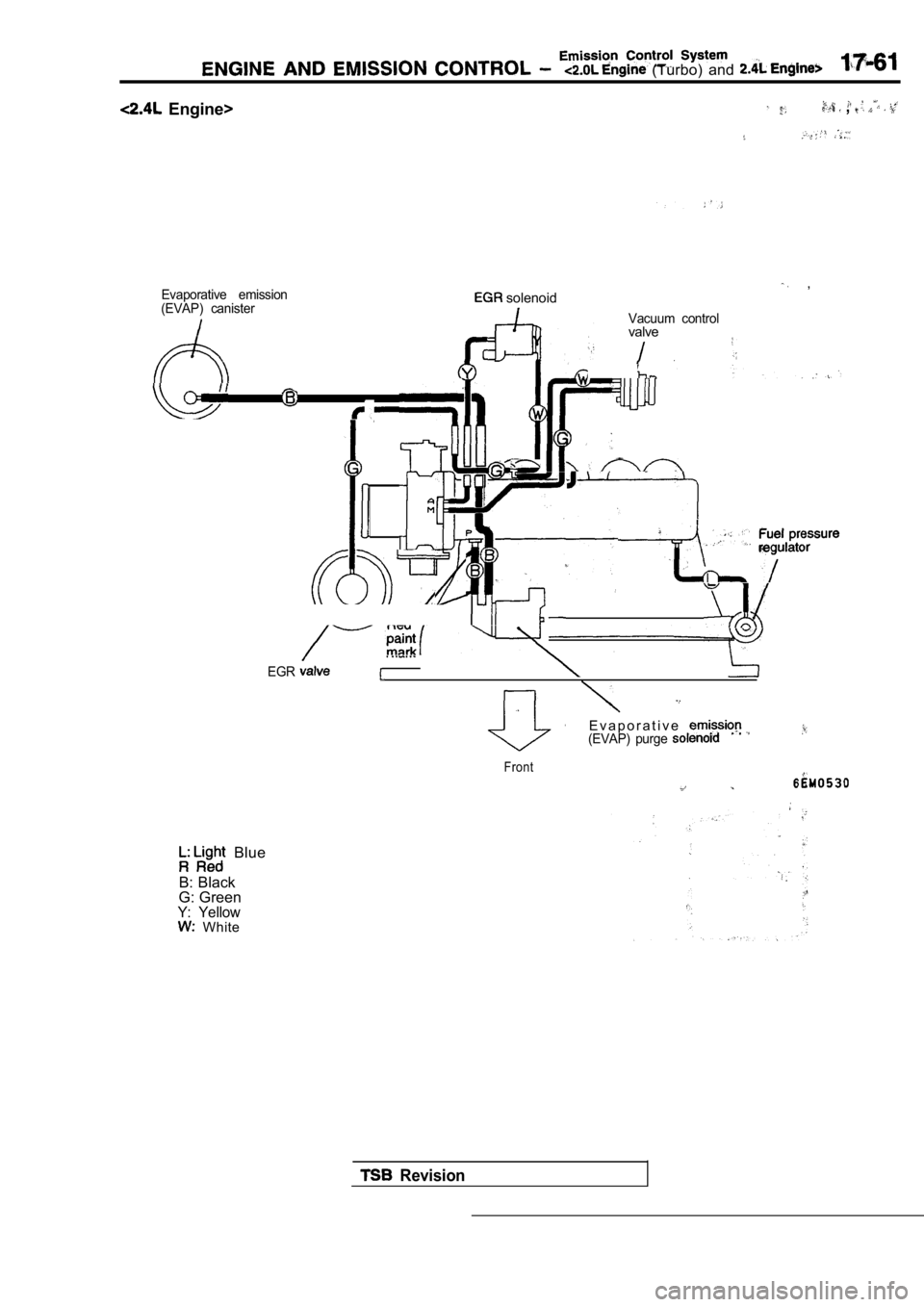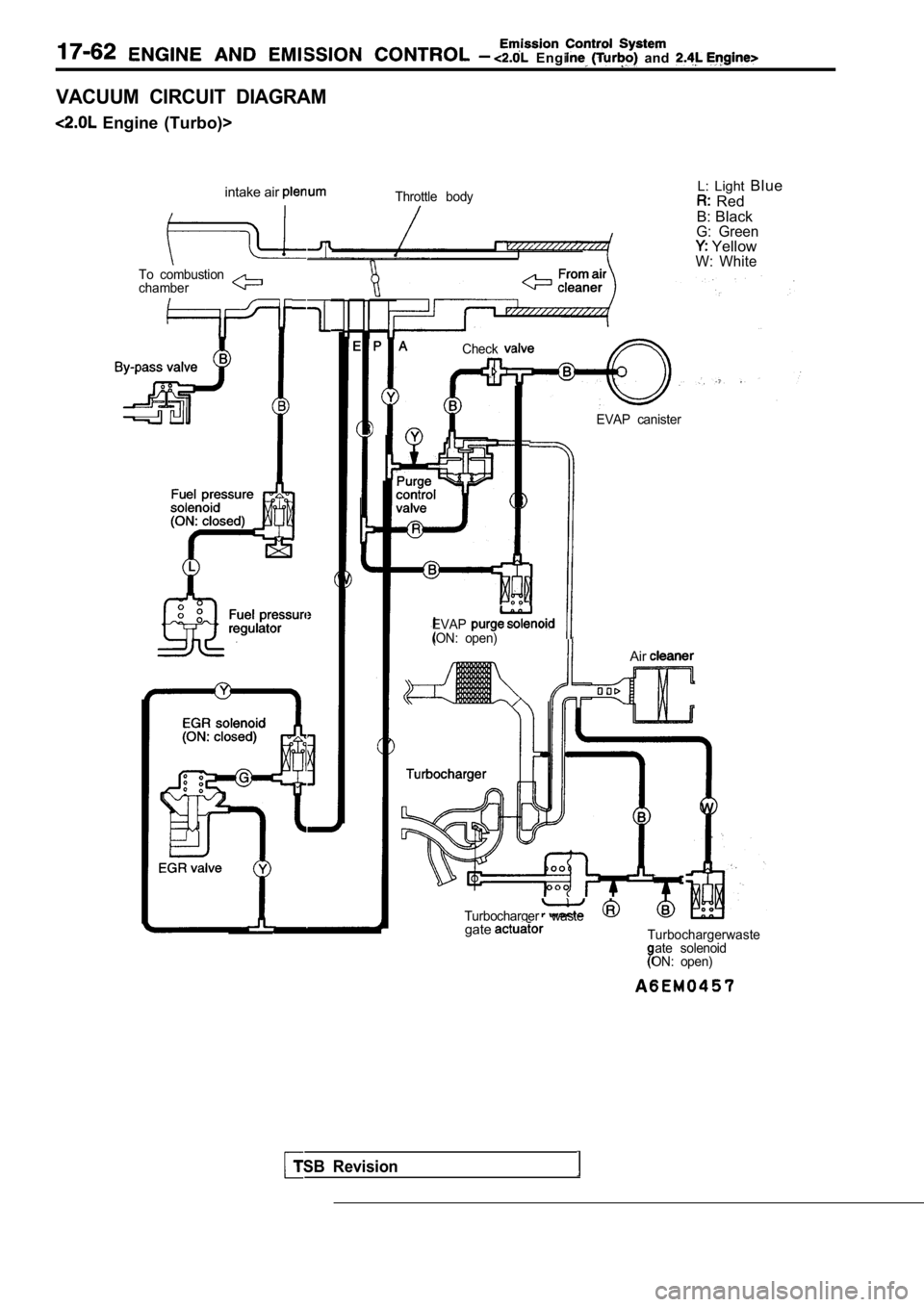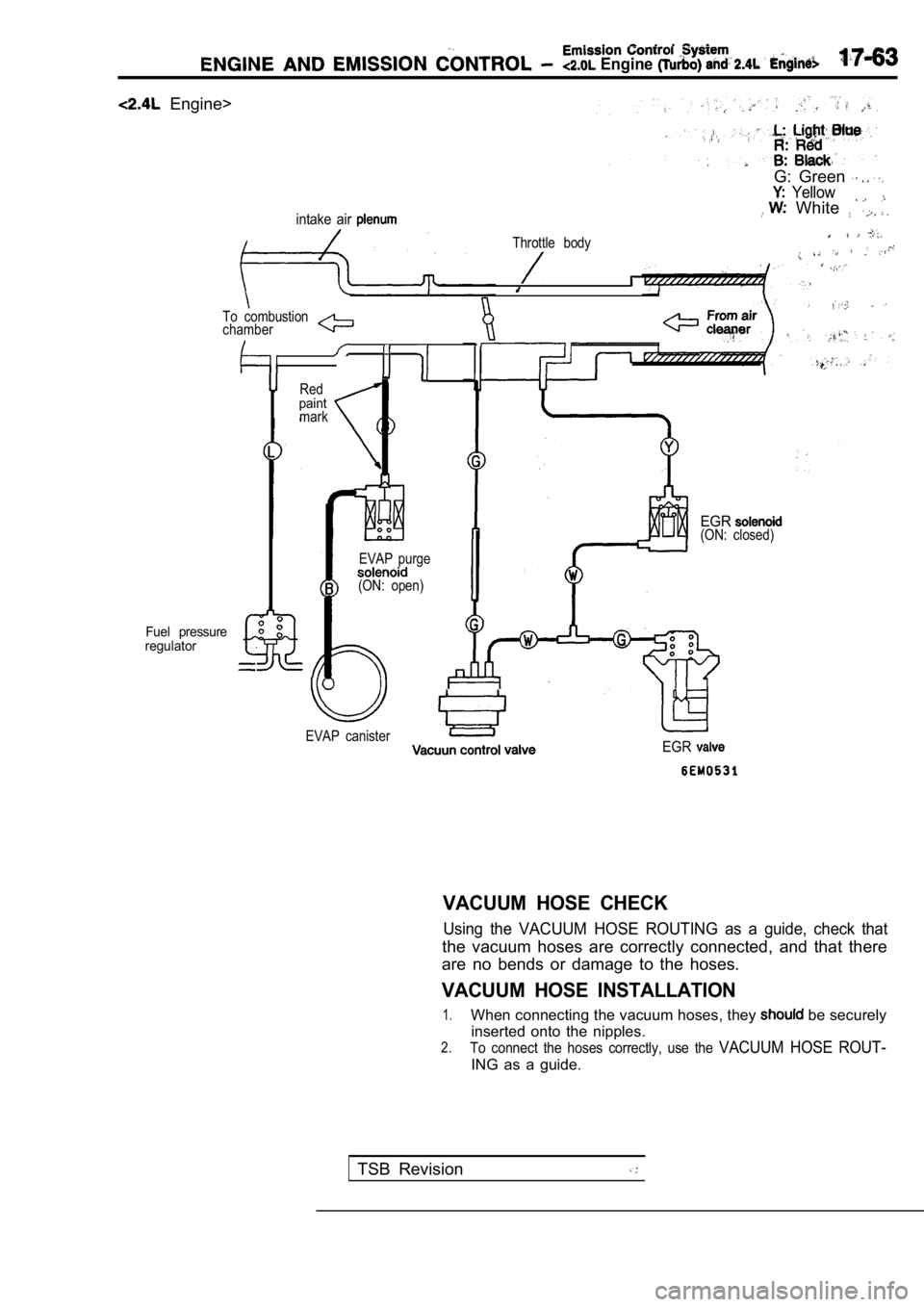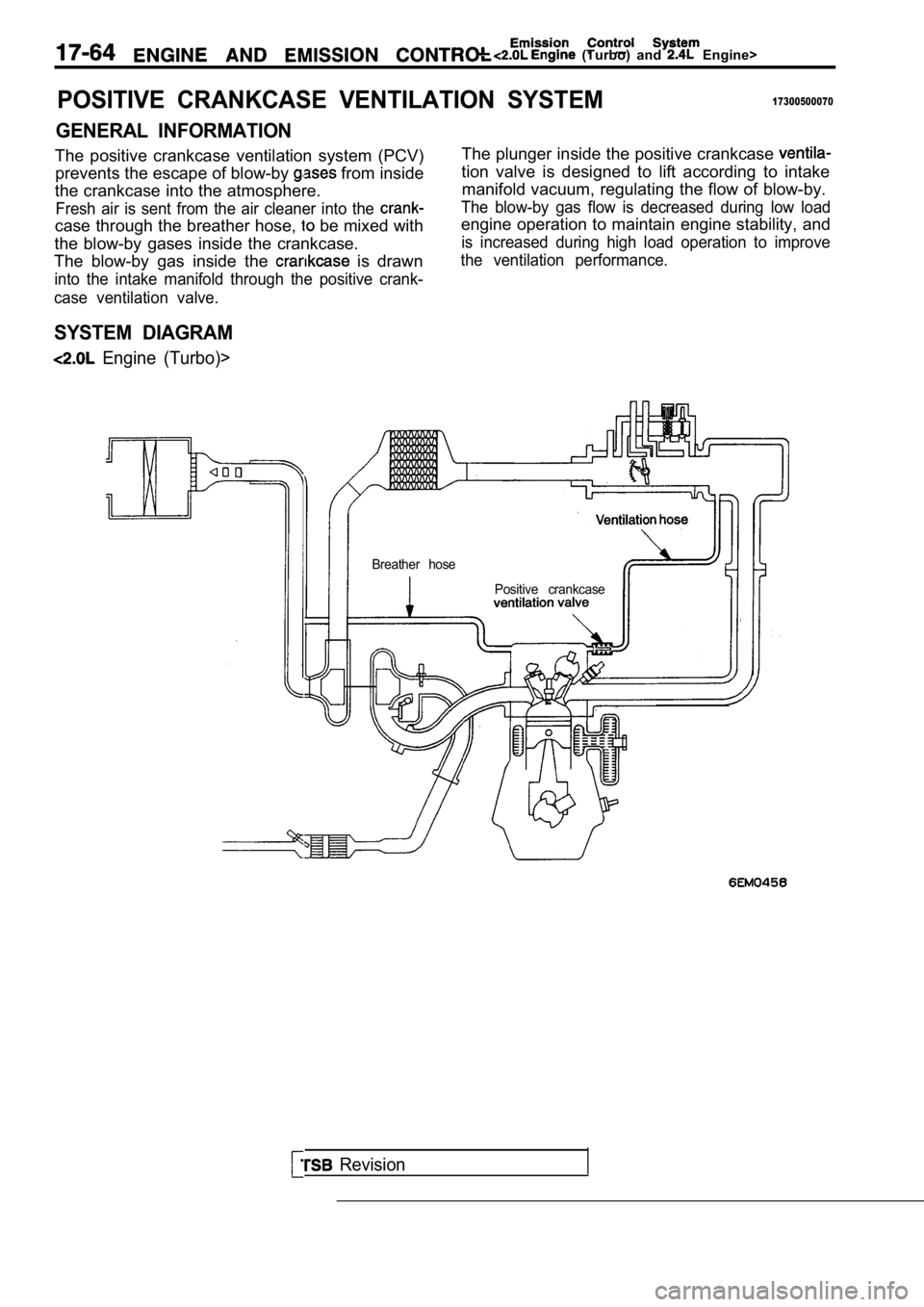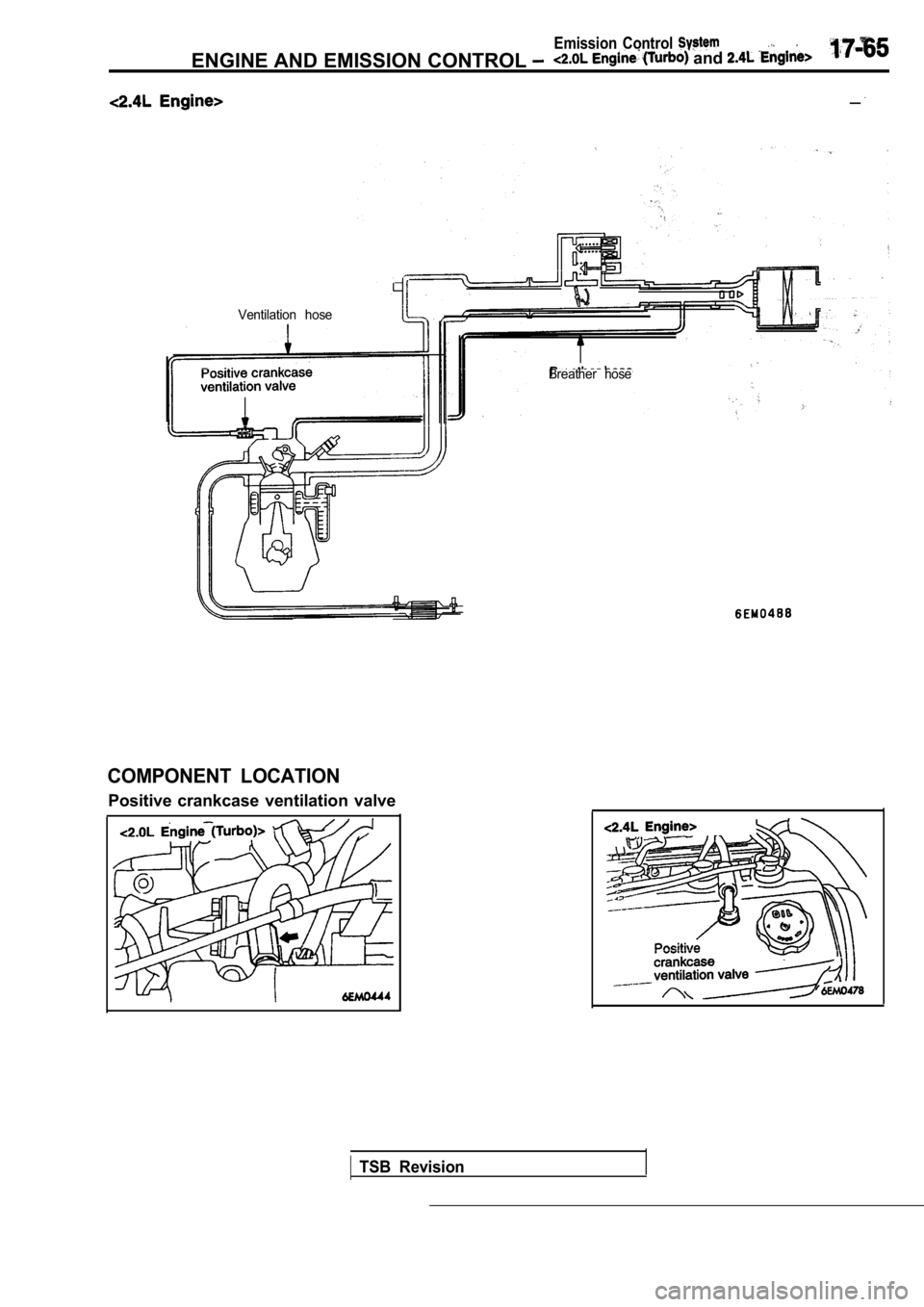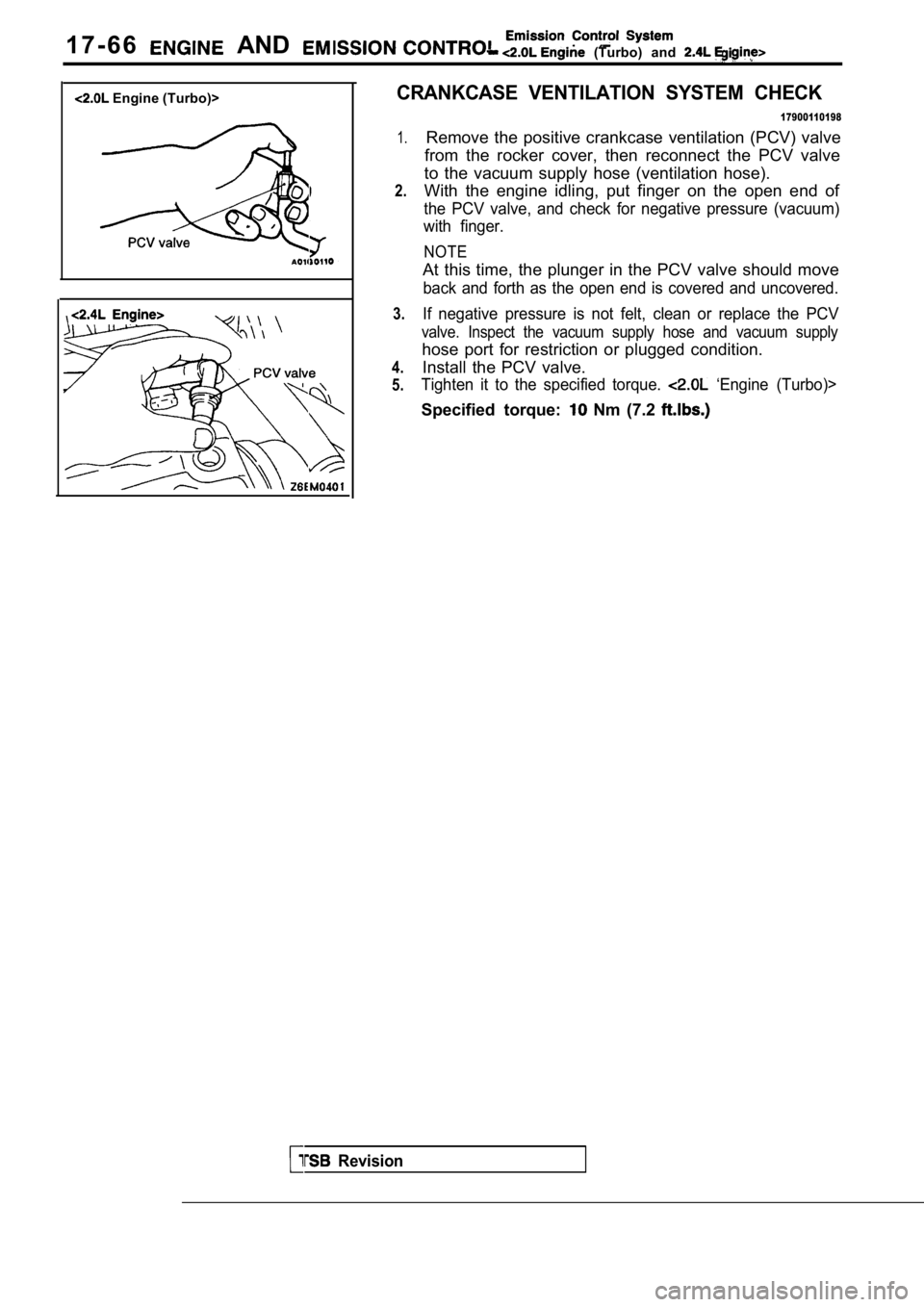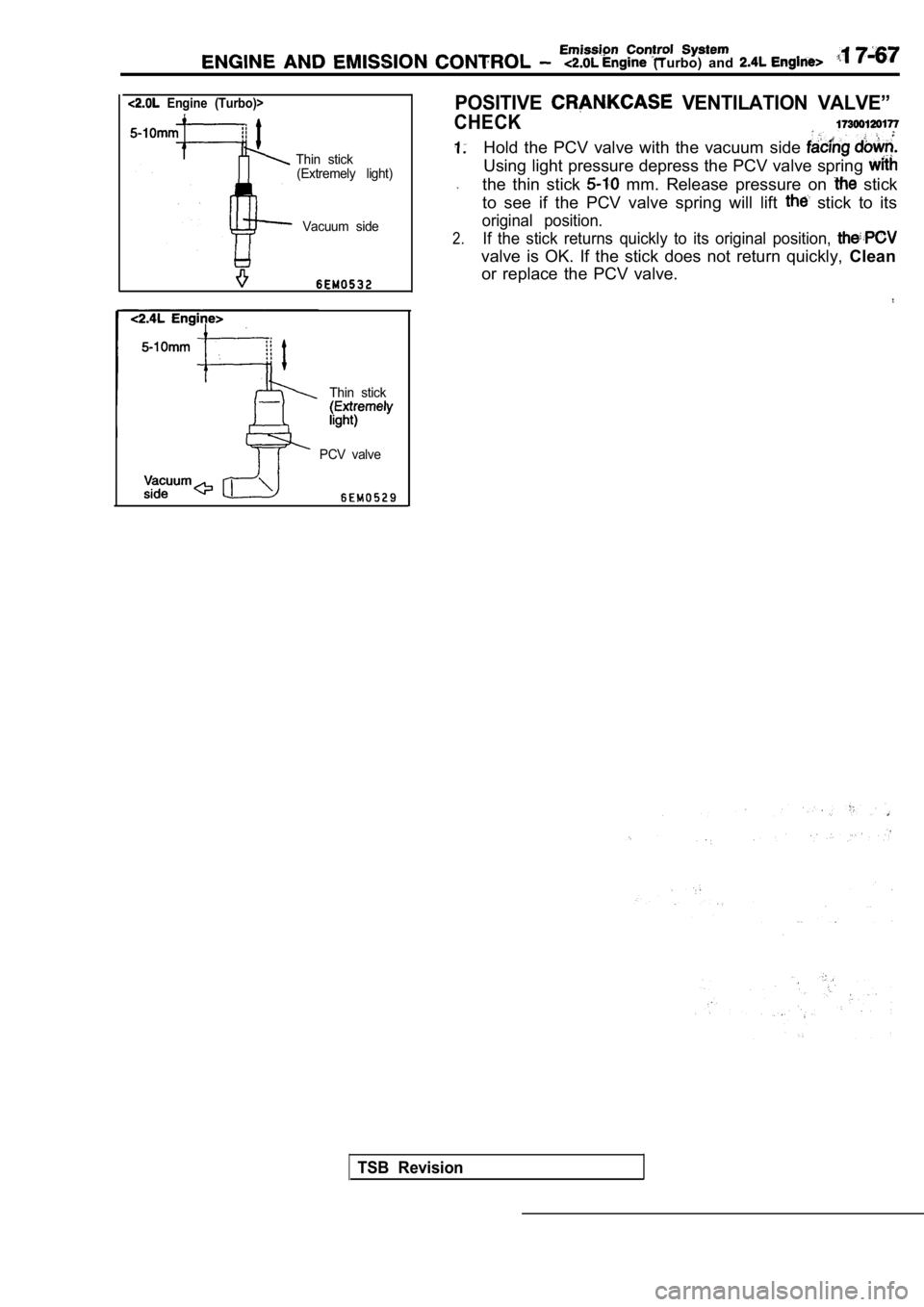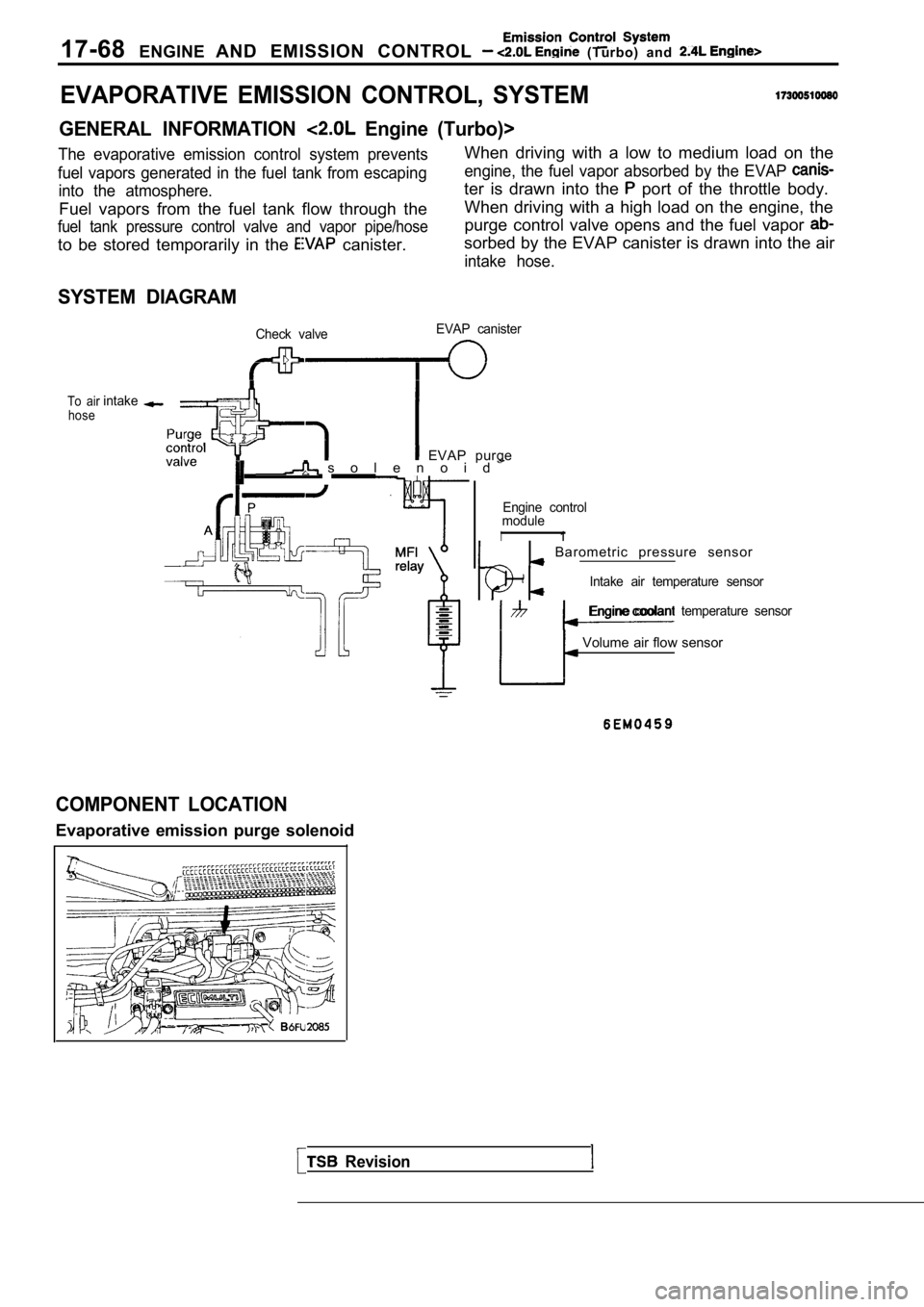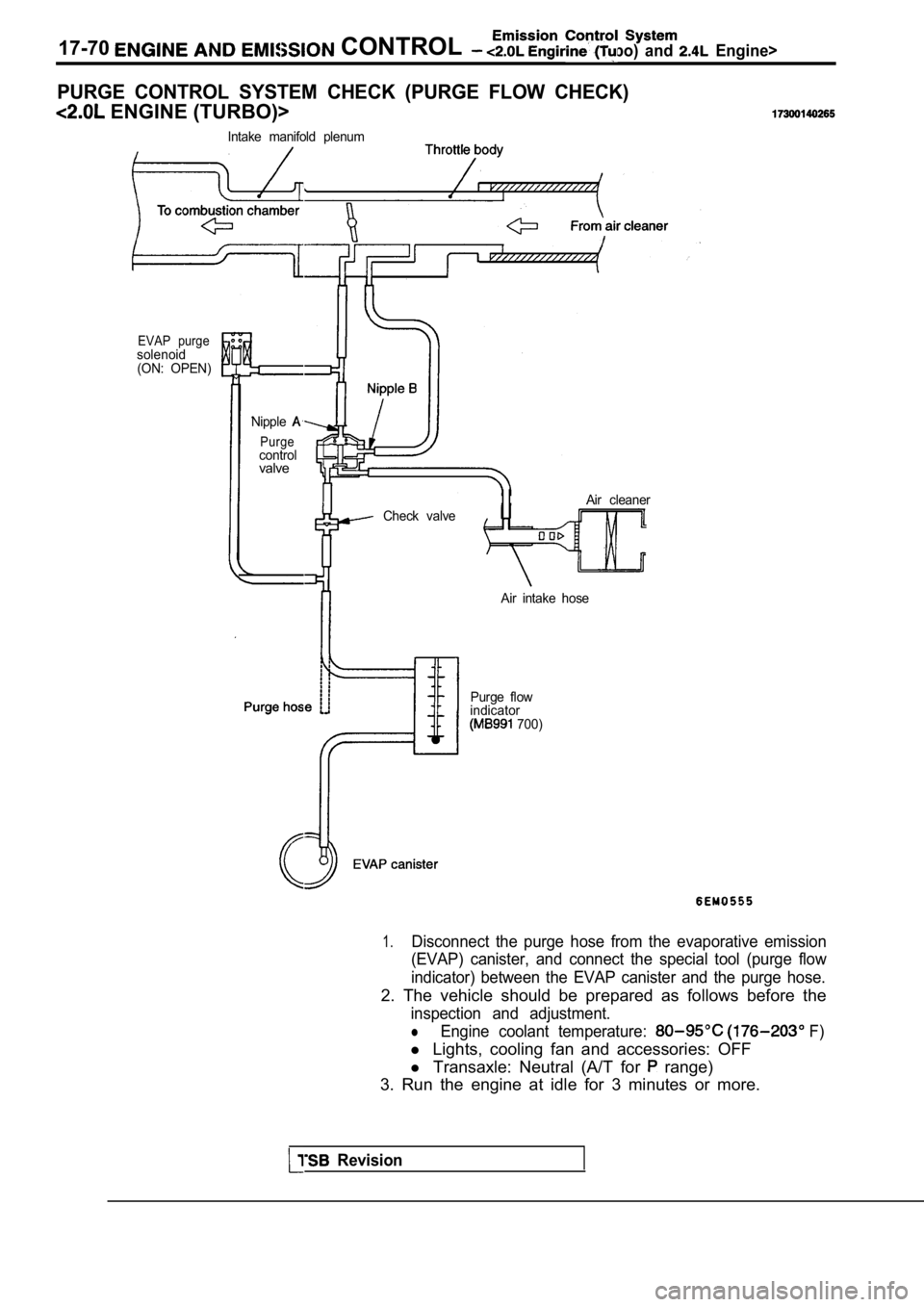MITSUBISHI SPYDER 1990 Service Repair Manual
SPYDER 1990
MITSUBISHI
MITSUBISHI
https://www.carmanualsonline.info/img/19/57345/w960_57345-0.png
MITSUBISHI SPYDER 1990 Service Repair Manual
Trending: wiper blades, lights, radiator cap, sensor, air bleeding, fuel cap, radio antenna
Page 801 of 2103
Evaporative emission
(EVAP) canister , solenoid
Vacuum controlvalve
EGR
E v a p o r a t i v e(EVAP) purge
Front
(Turbo) and
Engine> ,
Blue
B: Black
G: Green
Y: Yellow White
Revision
Page 802 of 2103
Engine and
VACUUM CIRCUIT DIAGRAM
Engine (Turbo)>intake air
Throttle bodyL: Light Blue
Red
B: Black
G: Green YellowW: WhiteTo combustion
chamber
Check
EVAP(ON: open)
EVAP canister
TSB Revision
Air
Turbocharger wastegateTurbochargerwasteate solenoid
ON: open)
Page 803 of 2103
Engine
Engine>
intake air
To combustion
chamber
G: Green
Yellow
White
Throttle body
Fuel pressure
regulator
Redpaintmark
EVAP purge
(ON: open)
EVAP canister
EGR(ON: closed)
EGR
VACUUM HOSE CHECK
Using the VACUUM HOSE ROUTING as a guide, check tha t
the vacuum hoses are correctly connected, and that there
are no bends or damage to the hoses.
VACUUM HOSE INSTALLATION
1.When connecting the vacuum hoses, they be securely
inserted onto the nipples.
2.To connect the hoses correctly, use the VACUUM HOSE ROUT-
ING as a guide.
TSB Revision
Page 804 of 2103
(Turbo) and Engine>
POSITIVE CRANKCASE VENTILATION SYSTEM17300500070
GENERAL INFORMATION
The positive crankcase ventilation system (PCV)prevents the escape of blow-by
from inside
the crankcase into the atmosphere.
Fresh air is sent from the air cleaner into the
case through the breather hose, be mixed with
the blow-by gases inside the crankcase.
The blow-by gas inside the
is drawn
into the intake manifold through the positive crank -
case ventilation valve.
The plunger inside the positive crankcase
tion valve is designed to lift according to intake manifold vacuum, regulating the flow of blow-by.
The blow-by gas flow is decreased during low load
engine operation to maintain engine stability, and
is increased during high load operation to improve
the ventilation performance.
SYSTEM DIAGRAM
Engine (Turbo)>
Breather hose
Positive crankcase
Revision
Page 805 of 2103
ENGINE AND EMISSION CONTROL
Emission Control and
__
Ventilation hoseBreather hose
COMPONENT LOCATION
Positive crankcase ventilation valve
TSB Revision
Page 806 of 2103
1 7 - 6 6 AND (Turbo) and
Engine (Turbo)>CRANKCASE VENTILATION SYSTEM CHECK
1.
2.
3.
4.
5.
17900110198
Remove the positive crankcase ventilation (PCV) val ve
from the rocker cover, then reconnect the PCV valve
to the vacuum supply hose (ventilation hose).
With the engine idling, put finger on the open end of
the PCV valve, and check for negative pressure (vacuum)
with finger.
NOTE
At this time, the plunger in the PCV valve should m ove
back and forth as the open end is covered and uncov ered.
If negative pressure is not felt, clean or replace the PCV
valve. Inspect the vacuum supply hose and vacuum su pply
hose port for restriction or plugged condition.
Install the PCV valve.
Tighten it to the specified torque. ‘Engine (Turbo)>
Specified torque: Nm (7.2
Revision
Page 807 of 2103
(Turbo) and
Engine (Turbo)>
Thin stick(Extremely light)
Vacuum side
Thin stick
PCV valve
POSITIVE VENTILATION VALVE”
CHECK
Hold the PCV valve with the vacuum side
Using light pressure depress the PCV valve spring
the thin stick mm. Release pressure on stick
to see if the PCV valve spring will lift
stick to its
original position.
2.If the stick returns quickly to its original positi on,
valve is OK. If the stick does not return quickly, Clean
or replace the PCV valve.
TSB Revision
Page 808 of 2103
17-68ENGINEAND EMISSION CONTROL (Turbo) and
EVAPORATIVE EMISSION CONTROL, SYSTEM
GENERAL INFORMATION Engine (Turbo)>
The evaporative emission control system preventsWhen driving with a low to medium load on the
fuel vapors generated in the fuel tank from escapin gengine, the fuel vapor absorbed by the EVAP
into the atmosphere.ter is drawn into the port of the throttle body.
Fuel vapors from the fuel tank flow through the When driving with a high load on the engine, the
fuel tank pressure control valve and vapor pipe/hos
epurge control valve opens and the fuel vapor
to be stored temporarily in the canister.sorbed by the EVAP canister is drawn into the air
intake hose.
SYSTEM DIAGRAM
Check valve EVAP canister
To air
hoseintake
EVAP purge s o l e n o i d
Revision
Engine control
module
I1
Barometric pressure sensor
Intake air temperature sensor
Engine coolant temperature sensor
Volume air flow sensor
COMPONENT LOCATION
Evaporative emission purge solenoid
Page 809 of 2103
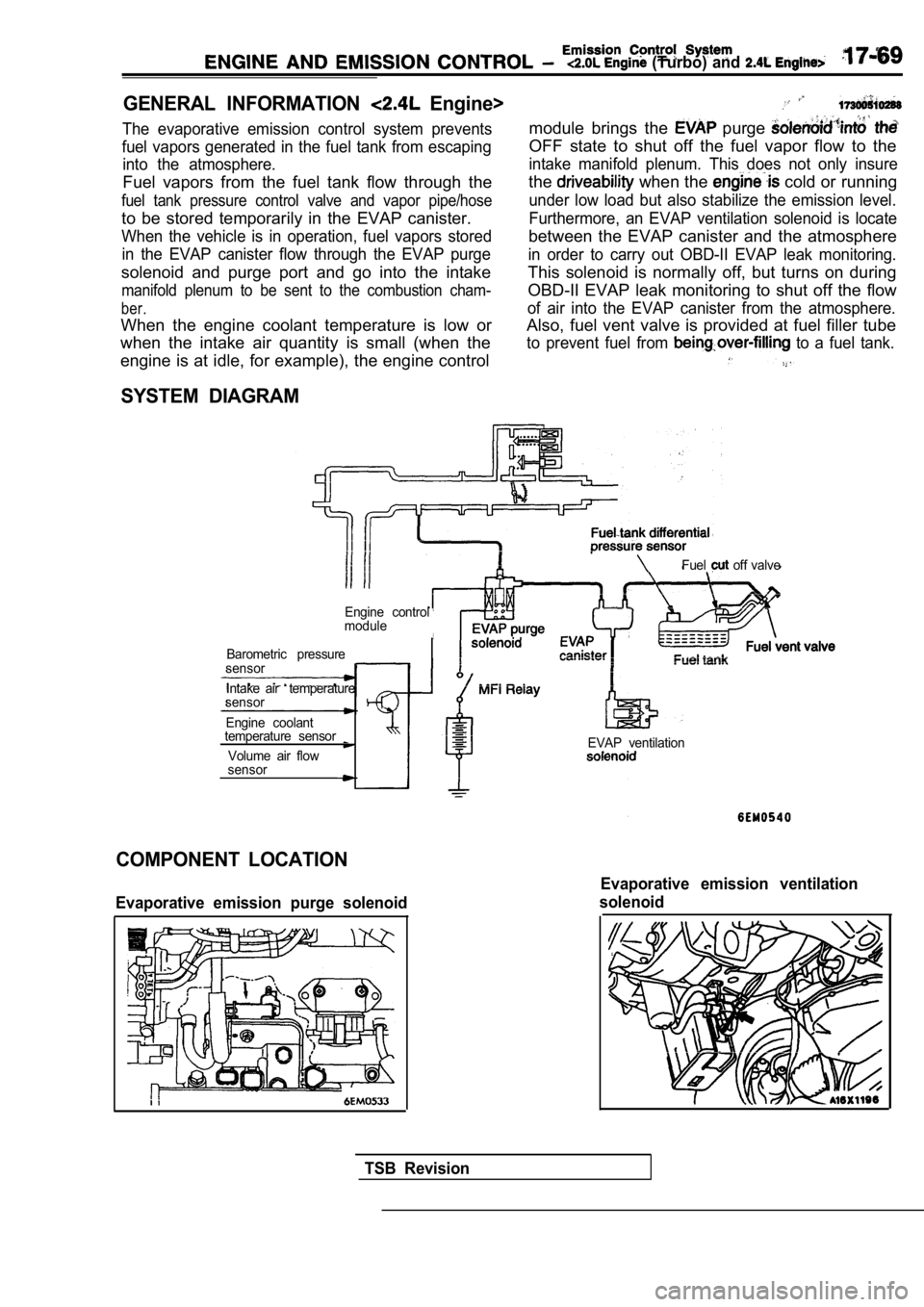
(Turbo) and
GENERAL INFORMATION Engine>
The evaporative emission control system prevents
fuel vapors generated in the fuel tank from escapin g
into the atmosphere.
Fuel vapors from the fuel tank flow through the
fuel tank pressure control valve and vapor pipe/hos e
to be stored temporarily in the EVAP canister.
When the vehicle is in operation, fuel vapors stored
in the EVAP canister flow through the EVAP purge
solenoid and purge port and go into the intake
manifold plenum to be sent to the combustion cham-
ber.
When the engine coolant temperature is low or
when the intake air quantity is small (when the
module brings the purge
OFF state to shut off the fuel vapor flow to the
intake manifold plenum. This does not only insure
the when the cold or running
under low load but also stabilize the emission leve l.
Furthermore, an EVAP ventilation solenoid is locate
between the EVAP canister and the atmosphere
in order to carry out OBD-II EVAP leak monitoring.
This solenoid is normally off, but turns on during
OBD-II EVAP leak monitoring to shut off the flow
of air into the EVAP canister from the atmosphere.
Also, fuel vent valve is provided at fuel filler tu be
to prevent fuel from to a fuel tank.
engine is at idle, for example), the engine control
SYSTEM DIAGRAM
Fuel off valve
Engine control
module
Barometric pressure
sensor
Intake air temperature
sensor
Engine coolant
temperature sensor
Volume air flow
sensorEVAP ventilation
COMPONENT LOCATION
Evaporative emission purge solenoid
Evaporative emission ventilation
solenoid
TSB Revision
Page 810 of 2103
17-70 CONTROL (Turbo) and Engine>
PURGE CONTROL SYSTEM CHECK (PURGE FLOW CHECK)
ENGINE (TURBO)>
Intake manifold plenum
EVAP purgesolenoid(ON: OPEN)
Nipple
Purgecontrolvalve
Check valve Air cleaner
Air intake hose
Purge flow
indicator
700)
1.Disconnect the purge hose from the evaporative emis sion
(EVAP) canister, and connect the special tool (purg e flow
indicator) between the EVAP canister and the purge hose.
2. The vehicle should be prepared as follows before the
inspection and adjustment.
lEngine coolant temperature: F)
l Lights, cooling fan and accessories: OFF
l Transaxle: Neutral (A/T for
range)
3. Run the engine at idle for 3 minutes or more.
Revision
Trending: suspension, coolant temperature, tires, change key battery, brake pads, fuel pressure, boot
